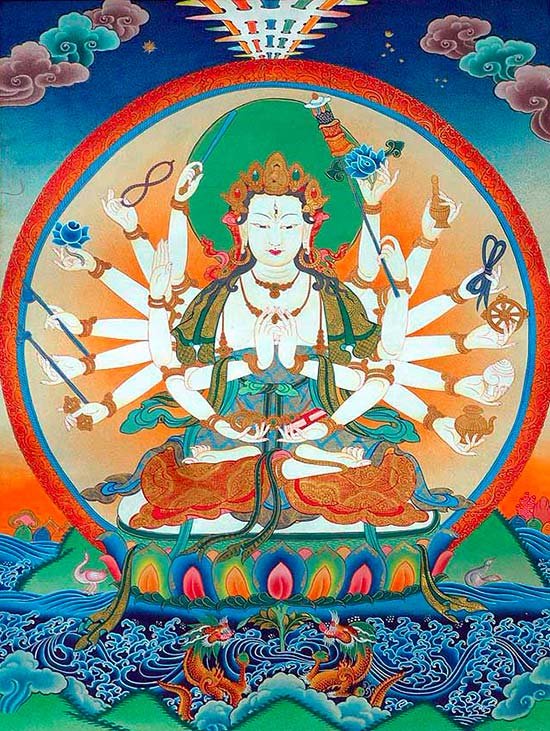Maha Prajnaparamita Sastra
by Gelongma Karma Migme Chödrön | 2001 | 941,039 words
This page describes “the buddha emits light rays from various body parts” as written by Nagarjuna in his Maha-prajnaparamita-sastra (lit. “the treatise on the great virtue of wisdom”) in the 2nd century. This book, written in five volumes, represents an encyclopedia on Buddhism as well as a commentary on the Pancavimsatisahasrika Prajnaparamita.
Act 1.4: The Buddha emits light rays from various body parts
Sūtra: In the same way, beams of six hundred prabhedakoṭi of rays are emitted (niśceruḥ) from the ten toes of his feet (pādāṅguli), from his two ankles (gulpha), from his two thighs (jaṅghā), from his two knees (jānumaṇḍala) from his two hips (kaṭi), from his spine (pṛṣṭha), from his belly (udara), from his sides, from his navel (nābhi), from the ‘śrīvatsa’ mark on his chest (hṛdayaśrīvatsa), from his shoulders (aṃsa),[1] from his arms (bāhu), from his hands (hasta), from his ten fingers (aṅguli), from his neck (grīvā), from his mouth (mukha), from his forty teeth (danta), from his two nostrils (ghrāṇa), from his two eyes (cakṣus), from his two ears (śrotra), from his urṇā and from his uṣṇīṣa.[2]
Śāstra. – If the rays that shoot out from the soles of his feet can illuminate the trisāhasramahāsāhasralokadhātu and the universes of the ten directions, why do the other parts of his body also shoot out six hundred prabhedakoṭi of rays?
Answer. – I have said above that the rays from the soles of his feet light up the direction of the nadir (adhastād diś), but do not fill the other directions; this is why the Buddha also emits rays from [the other] parts of his body. Some say that the feet, the support (pratiṣṭhāna) of the entire body, are the most important and, for this reason, the Buddha emits six hundred prabhedakoṭi of rays from the soles of his feet. By so doing, he shows beings that, of his thirty-two marks (dvātriṃsallakṣaṇa), the foremost consists of having his feet well-planted (supratiṣṭhitapādatala), but that the other parts of his body have also a miraculous power (ṛddhibala).
Question. – On which samādhi, on which abhijñā and on which dhyāna does the Buddha depend (āśrita) to emit his rays?
Answer. – Among all the samādhis, he depends on the Samādhirājasamādhi; among the six abhijñās, he depends on the abhijñā of miraculous power (ṛddhyabhijñā); among the four dhyānas, he depends on the fourth dhyāna. The fire of the fourth dhyāna surpasses ordinary fire, and all who enter into it emit rays.
Moreover, when he was born, when he attained bodhi and when he set in motion the wheel of Dharma (dharmacakra), the Buddha emitted immense rays that filled the ten directions. Why then would he not emit rays when he preaches the Mahāprajñāpāramitā?
The jewels of a cakravartin king usually have a brilliance that illuminates the king and his army on all four sides to a distance of one yojana.[3]It is the same for the Buddha: if he did not enter into samādhi, he would emit only his usual light (prakṛtiprabhā).[4] What is that? It is the light of the Three Jewels: the Buddha, the Dharma and the Saṃgha.
Footnotes and references:
[1]:
See, for example, the statue found near Kabul which is in the Calcutta museum showing the Buddha surrounded by flames coming from his shoulders (Foucher, Art Gréco-bouddhique, II, fig. 463, p. 331 and 369, note).
[2]:
Cf. Pañcaviṃśati, p. 6, and Śatasāhasrikā, p. 7–8.
[3]:
Cf. Milinda, p. 118: cakkavattimaṇi samantā yojanaṃ obhāseti.
[4]:
Below, k. 8, p. 114c, the Buddha will exhibit this usual light (prakṛtiprabhā) which is one arm-span in width and surpasses the light of a thousand suns. This will be Act III.
